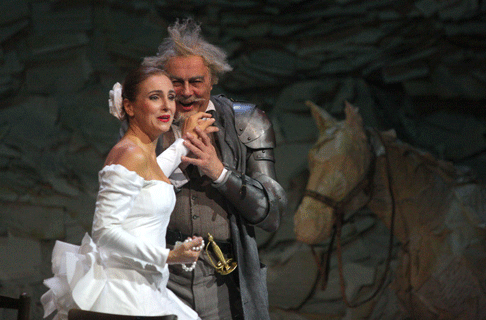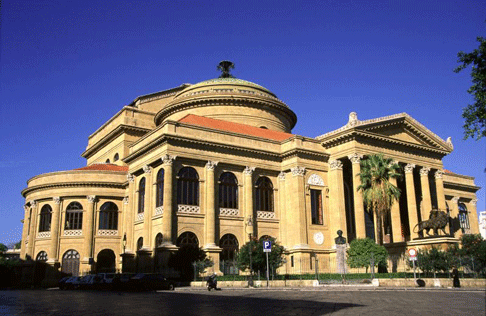Happily, once inside this spectacular architectural marvel, the production of Don Quichotte was similarly chockfull of awesome surprises and considerable beauty.
Palermo, to be sure, is one of Italy’s leading companies and they stake their reputation on a well-considered mix of tried and true stars, standard and adventurous repertoire. In this instance, they began by engaging the world-renowned director Laurent Pelly to work his magic with a lesser Massenet opus, one more famed in our imagination as the Cervantes source story than this diluted French opera rendition. As a piece of composition the work is curiously paced, at times rip-snorting, more often gently introspective as dictated by the librettist’s erratic choices of which iconic episodes to feature and, more telling, which to omit.
Mr. Pelly’s fertile imagination is fully engaged here, and he made me believe this is a more significant opera than it really is. His overall concept centers around the conceit that Massenet himself is onstage as the protagonist and he morphs into Quixote as he pens the work. He was ably supported by the ingenious scenery created by Barbara de Limburg Stirum. She featured heaping mounds of manuscripts that first formed a staircase of sorts to DulcinÈe’s balcony, and later actually created the massive rolling hills of the countryside. Highly impressive and impressionistic, this proved a perfect complement to the score’s aural palette.
Pelly not only masterfully moved the large chorus through meaningful staged numbers, but maintained exceptional focus on the interaction of his principals. The fluidity of crowd scenes and the clarity of the story-telling were always infused with generous heart and good dramatic purpose. And wit. Let us not forget wit. To wit:
The famous “tilting at windmills” was arguably the visual highpoint of the night. First, a windmill blade flew in from on high, then another unfolded from it and in a twinkle there was a dazzling windmill in full rotation. But unlike, say, Man of La Mancha which relegates the actual battle to an offstage moment, Laurent and Barbara contrived a sensational visual effect, having Quixote first settle into what looks to be a rocky seat that is part of the landscape. But, whoa Nelly, this seat soon pokes forward from the hillside on a giant arm bearing our hero aloft toward the slicing blades. But that’s not yet all. It then begins a crazed dip-and-soar like the old Octopus ride at the county fair. It was so dazzling that it became a hard act to follow.
 Irini Karaianni as DulcinÈe and Ferruccio Furlanetto as Don Quichotte
Irini Karaianni as DulcinÈe and Ferruccio Furlanetto as Don Quichotte
But the team had more in store. Act IV featured an extensive terrace and staircase placed neatly atop the hillside of papers, and was fleshed out with other highly evocative images such as having DulcinÈe dance with three men sporting tall, skinny horse head masks/hats. Not only powerful sexual imagery, but also a nice touch of spice to flavor the drawn out conflict in the scene. If I had one wish scenically, it would be that they not have taken time to close the curtain, remove the terrace and restore the hills to their previous unadorned state for Act V. It took the dramatic momentum away when the piece could least afford it, and visually it did not make any notable effect.
Oddly, the director has the leading man die standing up, albeit leaning, skewed at an angle, obviously braced somehow. He was beautifully lit in a pool of golden light (did I mention the excellent, ever shifting lighting was by Joel Adam?) but I wondered if the effect was worth the effort or worth the wait. This production was shared with Brussels’ Theatre Monnaie/DeMunt, and re-staged by Diane ChËvre-ClÈment. Should it be re-mounted, I might suggest they simply pull Quixote and Sancho in front of the act curtain seamlessly after Act IV, light them in isolation, and just let Act V continue the emotional momentum and limpid musical atmosphere.
Evergreen bass Ferruccio Furlanetto showed splendid command of all his resources here, and his Don was noted for an outpouring of burnished tone, heartfelt phrasing, comic abandon (with no trace of buffoonery), and very decent French to boot. He effortlessly carried the show as any good Quixote must. And he was matched every step of the way by Eduardo Chama’s lively rendition of Sancho Panza. Mr. Chama has a bright, well-placed baritone that has good ping and responsive technique. He was a perfect foil for Mr. Furlanetto and the two set off dramatic sparks on many occasions. Too, Eduardo communicated a touchingly simple admiration for his master that illuminated every bit of pathos that Massenet intended. Furlanetto and Chama were a wholly winning, first-rate combination.
In the less well-written female role, the fetching Irini Karaianni brought much visual and aural pleasure to the proceedings with her quite bewitching DulcinÈe. Her smoky mezzo has a hint of darkness overall, but the highest notes slipped into a rather bright upper extension. She does not press her chest voice, but nevertheless commands a decent amount of presence in the lower extremes. It is to her credit (and Pelly’s) that Ms. Karaianni manages to bring sympathy and a third dimension to one of the repertoire’s thinnest sketches of a character. The remaining quartet of principals was well-cast with Elisabetta Martorana a silver-voiced Pedro; Rachele Stanisci a persuasive Garcias; Salvatore Ragonese a secure Rodriguez; and first among equals, Gianluca Sorrentino, a honey-toned Juan.
Alain Guingal conducted lovingly and with such knowing detail that he seemed to wholly believe Don Quichotte is the masterpiece it isn’t. His players responded in kind with beautifully atmospheric ensemble work and solo passages ripe with musical personality. In a work that often relies on diffuse, languid effects Maestro Guingal found freshness and a pulsating arc from the first downbeat to the final cut-off. In tandem, Andrea Faidutti’s well prepared chorus sang cleanly even when frequently moving about in (slightly over-)choreographed scenes.
 Teatro Massimo
Teatro Massimo
On the other side of the island, Catania’s Teatro Massimo Vincenzo Bellini was taking no chances with such novel repertoire, opting instead for a wholly competent La BohËme. The company seems to favor double- and even triple-casting the leads during the run, with an eye to including a handful of performances featuring a major star. In this case, that would be Sicilian Marcello Giordani’s Rodolfo.
Mr. Giordani is a known commodity, of course, a tenor whose substantial lirico-spinto voice is wedded to a reliable technique, persuasive stylistic acumen, ringing power, and sound delivery. Having brought his Rodolfo to many of the world stages, he knows this part inside out, and sings it exceedingly well. Would it be carping to say I would have appreciated even more a bit of spontaneity in his portrayal? Or a little more gradation of volume below a standard mezzo forte?
The first surprise of the evening to me was the young baritone Vincenzo Taormina as Marcello. Mr. Taormina has a rich, robust baritone of uncommon beauty and substantial power; unaffected stage presence; and possesses a fine understanding of the nuance of musical and dramatic effect that can be found in any role. He was easily Mr. Giordani’s equal and their Act IV duet was a high point of the evening. Vincenzo also has the benefit of conveying a youthfulness that was at odds with his other “young” Bohemians. To be fair, Fabio Previati’s well-sung Schaunard was almost as believable, but Alessandro Busi seemed miscast as Colline at this point in his career. His singing was sincere and secure enough, although veering a bit off-pitch in the upper stretches of the Coat Aria. But although he threw himself into the camaraderie completely, visually he looked as out of place as a fifty year old in the Student Union cafeteria.
The show’s major revelation was Donata d’Annunzio Lombardi as Mimi. Hers is a beautifully schooled soprano, capable of all the requirements Puccini sets out for his heroine. Conversational, introspective musings? Check. Ability to soar over the amassed vocal and instrumental forces? Check. Skill in floating delicate, secure, melting notes? Check. She may have a bit more edge than other recent definitive Mimi’s like Freni and Scotto. But Ms. Lombardi definitely has all the goods, not only for Mimi, but Butterfly and Liu and, and, and. Watch for her as her star continues to rise.
Sabrina Vianello contributed the sort of chirpy, light-voiced Musetta that we hardly ever encounter nowadays. Perhaps she brought more stage savvy and spunk than middle voice to the part, but she was always entertaining and, in the final scene, moving. The treasurable comprimario Angelo Nardinocchi did effective double duty as Benoit and Alcindoro (the former in as ill-fitting a skull cap as I hope to never see again).
In the pit, conductor Carlo Rizzari got everything settled down after a clumsy start. The band began out of sync for the first few bars, then plodded through a generally uninvolved, overplayed first act. But lo, once past a couple of minor ensemble hiccups in Act Two, the maestro and the orchestra seemed to relax, breathe with the singers, and go on to some truly luminous playing in the second half the show. Tiziana Carlini had prepared her large chorus well, and the children were especially effective.
Director Roberto Lagan‡ Manoli (also costume designer) and set designer Pierluigi Samartini generally played it safe with a pleasingly traditional, no nonsense mounting that punched all the right tickets. And why not? Left alone, in the hands of such wonderful artists, it pretty much plays itself. Not to say that Signor Manoli didn’t have a trick or two up his sleeve. Marcello is discovered at curtain rise on a mini scaffold painting a rather large canvas with (what I presume is) a witty nod to the opening of Tosca. When Colline bursts in with his booty in Act I, it is so substantial that three delivery boys have to help carry it in. The amassed choral forces at Momus were well managed, especially the positioning of hen well-tutored youth who were heard to maximum advantage.
On a few occasions there were misfires. An odd positioning of actors and indecisive spatial considerations made for an awkward hand holding set up to “Che gelida manina.” And some of Three was place too extremely left or right so as to render singers momentarily out of sightlines for a third of the audience. Too, while the sets were pleasant, it took way too long to change them, with the combined intermissions being longer than the piece itself.
Still, the SRO audience did not seem to care, and lingered long after curtain fall in the beautiful auditorium (one of Europe’s loveliest) to lavish the performers with extended ovations.
James Sohre
Cast lists:
Don Quichotte
DulcinÈe: Irini Karaianni
Don Quichotte: Ferruccio Furlanetto
Sancho: Eduardo Chama
Pedro: Elisabetta Martorana
Garcias: Rachele Stanisci
Rodriguez: Salvatore Ragonese
Juan: Gianluca Sorrentino
Conductor: Alain Guingal
Director and Costume Design: Laurent Pelly
Set Design: Barbara de Limburg Stirum
Lighting: Joel Adam
Restaged by Diane ChËvre-ClÈment
Chorus Master: Andrea Faidutti
Co-production with La Monnaie-De Munt, Brussels
La BohËme
Mimi: Donata d’Annunzio Lombardi
Rodolfo: Marcello Giordani
Musetta: Sabrina Vianello
Marcello: Vincenzo Taormina
Colline: Alessandro Busi
Schaunard: Fabio Previati
Benoit/Alcindoro: Angelo Nardinocchi
Parpignol: Michele Mauro
Conductor: Carlo Rizzari
Director and Costume Design: Roberto Lagan‡ Manoli
Set Design: Pierluigi Samartini
Lighting Design: Salvatore NoË
Chorus Master: Tiziana Carlini
image=http://www.operatoday.com/TMassimo-Don-Quichotte-FOTO.gif
image_description=Ferruccio Furlanetto as Don Quichotte [Photo courtesy of Teatro Massimo]
product=yes
product_title=Il Viaggio a Sicilia
product_by=See cast lists below
product_id=Above: Ferruccio Furlanetto as Don Quichotte
All photos courtesy of Teatro Massimo